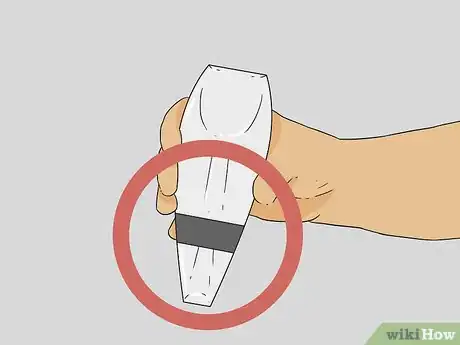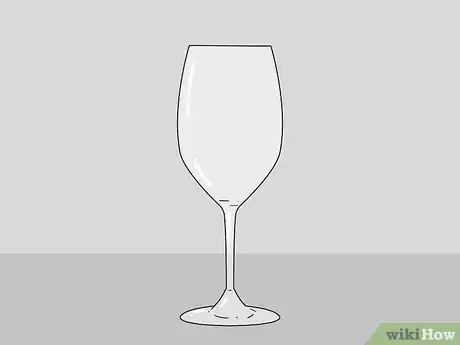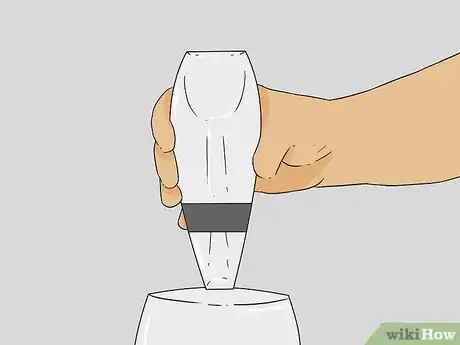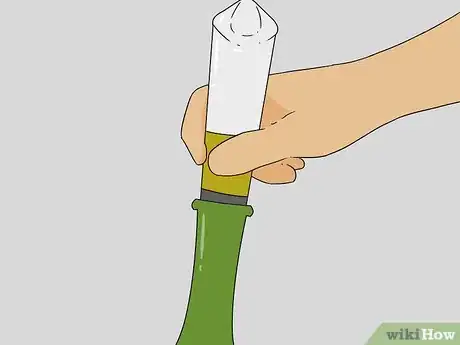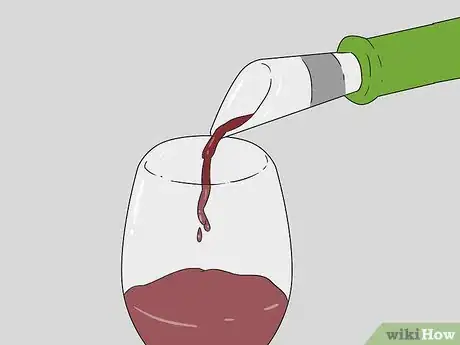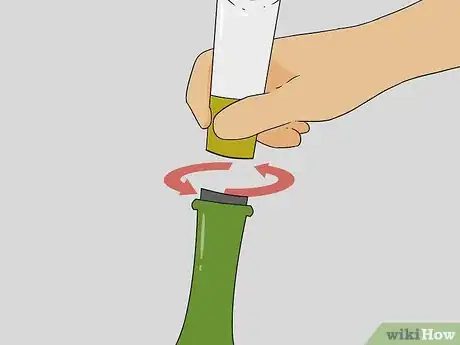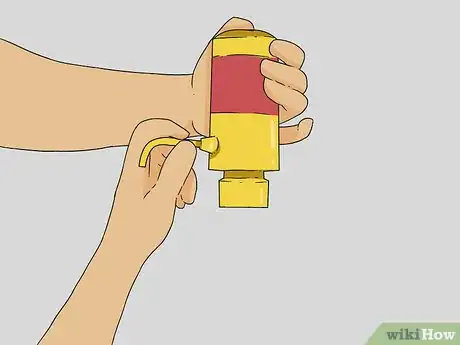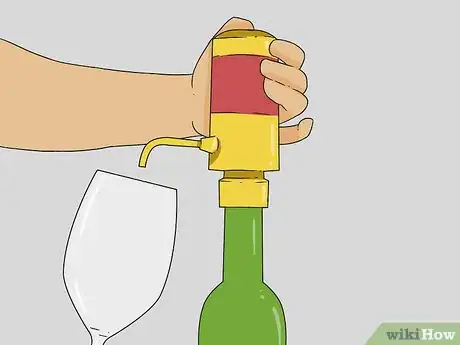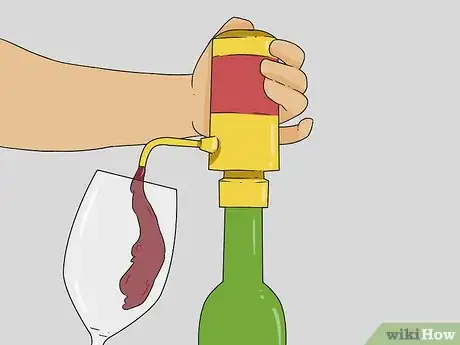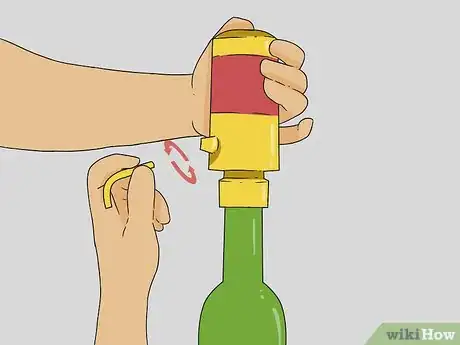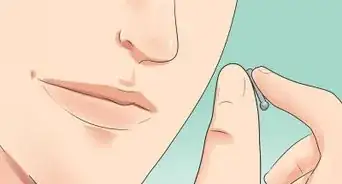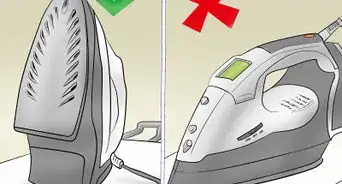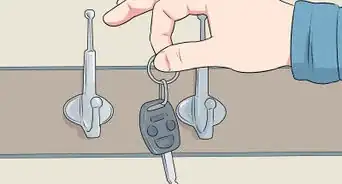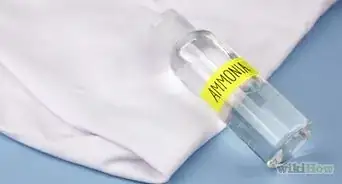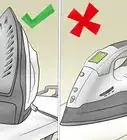This article was co-authored by Murphy Perng. Murphy Perng is a Wine Consultant and the Founder and Host of Matter of Wine, a business that produces educational wine events, including team-building experiences, networking events, and private parties. Based in Los Angeles, California, Murphy has served as a Wine Educator for clients such as Google, Buzzfeed, Tiktok, Snapchat, and Equinox and been featured on National Geographic and The Somm Journal. Murphy possesses her WSET (Wine & Spirit Education Trust) Level 3 Advanced Certification.
This article has been viewed 29,095 times.
The benefits of aerating wine include opening up the wine’s aroma, softening the flavor profile, and improving its character. There are three types of wine aerators – handheld, automated and pourers. Using handheld aerators requires positioning the aerator above a wine glass, then pouring the wine into the aerator. Automated aerators are inserted into a wine bottle, and wine is then dispensed from a spigot extending away from the bottle. Aerator pourers are inserted into a wine bottle directly (like a cork) then poured into a wine glass directly.
Steps
Using a Handheld Aerator
-
1Place the filter over the aerator. The filter will prevent sediment and bits of cork from falling into the aerator (and from there, into your glass). The filter should clip directly onto the top of your aerator and fit snugly within the open recess.[1]
-
2Position your wine glass for pouring. After selecting a wine and the appropriate wine glass, position the glass on a flat surface. You may not have a free hand, depending on your aerator's design, so ensure that the wine glass is positioned steadily.[2]
-
3Position the wine aerator over your glass. Hold the aerator in such a way that you do not block the airholes. If air cannot flow freely through the aerator, your wine will not get aerated because air oxidizes the wine and opens it up.[3] Position the aerator’s spout just below the rim of the wine glass.[4]
-
4Pour the wine into the wine aerator. After opening the bottle of wine, you can pour the liquid through the aerator. Continue to hold the aerator carefully above the wine glass with one hand while pouring from the bottle with your other hand. The aerator will have a large opening at the top designed for easy pouring.[5] There is a nozzle at the bottom through which the wine exits after being aerated.[6]
- Do not fill the wine aerator too fast. The aerator’s chamber should never be more than half full as you pour.
Using an Aerator Pourer
-
1Affix the aerator to the wine bottle. After uncorking your wine, snap the aerator pourer into place. Generally, you can do this by simply pushing one end carefully into the top of the wine bottle.[7]
- You can usually identify which end of the wine aerator pourer snaps into the bottle by looking for a rubber nozzle with a series of rings around it. Push this end into the wine bottle.
- You can identify the top of the wine aerator pourer by looking for a metal or plastic spout. Some aerator pourers feature narrow, straw-like extensions protruding from their tops.
-
2Pour your wine. With the aerator pourer in place, position a wine glass on a flat, stable surface. Pour your desired volume of wine into the glass. Pour slowly, as the rate at which your wine comes out with an aerator pourer in place may be different than the rate at which you’re used to it coming out.
- Some aerator pourers require that you turn the bottle completely upside down in order to pour a glass. Others enable you to pour wine just as you would in the absence of an aerator pourer. If you find that your wine is not coming out of the bottle with the aerator pourer in place, continue tipping the bottle at a steeper angle until it does so.[8]
-
3Seal the wine bottle. Some aerator pourers come coupled with a wine stopper or feature a twist-top mechanism. This enables you to avoid the hassle of attaching and then removing the aerator pourer each time you wish to have a glass of aerated wine. To use the wine stopper, push the pointed or narrower end into the aerator pourer when you’ve finished drinking.[9]
- Some aerator pourers have a twist-operated stopper built into them. To use this, simply turn the aerator pourer (or some portion of it). You might have to turn the aerator pourer clockwise or counterclockwise. The wine will then be sealed just as it would be if it were corked.[10]
- If your aerator pourer does not feature a stopper or twist-top mechanism, pull it out of the bottle and wash it according to manufacturer directions. Seal the bottle using the cork.
Using an Automated Aerator
-
1Assemble the aerator. Assembly directions will differ depending on what model of automated aerator you select. Generally, you’ll have to insert batteries and attach an aeration tube (a long, straw-like object) to the aerator head (the main portion of the automated aerator out of which the wine will actually come out).
-
2Attach the automated aerator to the wine bottle. Slip the long tube extending away from the head of the automated aerator into the wine bottle. Once the tube is completely inside the bottle, gently press down on the aerator head. The aerator head should be pushed down far enough that it is stable within the bottle.
- Some automated wine aerators might have a rubber seal attached to the inside of the area where the tube and the head meet. This seal will ensure that the aerator head remains firmly in place during use.
-
3Place your glass beneath the spout at an angle. The spout of the automated aerator is the portion that extends horizontally away from the aerator head. Bring your glass up toward the spout with one hand. Hold the glass at a slight angle so that the top tilts slightly toward the wine bottle. Position the spout just slightly below the rim of the glass.
- Do not place your wine glass beneath the spout on a flat surface. This could cause you to miss the glass or cause the wine to splash when dispensed from the automated wine aerator.
-
4Dispense the wine from the automated aerator. When your glass is positioned properly, use your free hand to press the dispense button on the automated wine aerator. This button might be located on top or on the side of the automated aerator head. Release the button after the wine glass contains the volume of wine you wish to consume.
-
5Remove the automated aerator from the bottle. Re-cork your wine. Without detaching it, rinse the automated wine aerator’s tube off at the sink under running water. Then, fill an empty wine bottle with water and place the aerator in it. Dispense water from the automated wine aerator for about three seconds.
- Remove the aerator from the bottle and wipe the tube off with a clean cloth.
- Do not submerge your wine aerator in water or it will be ruined.
Expert Q&A
-
QuestionWhy do we aerate wines?
 Murphy PerngMurphy Perng is a Wine Consultant and the Founder and Host of Matter of Wine, a business that produces educational wine events, including team-building experiences, networking events, and private parties. Based in Los Angeles, California, Murphy has served as a Wine Educator for clients such as Google, Buzzfeed, Tiktok, Snapchat, and Equinox and been featured on National Geographic and The Somm Journal. Murphy possesses her WSET (Wine & Spirit Education Trust) Level 3 Advanced Certification.
Murphy PerngMurphy Perng is a Wine Consultant and the Founder and Host of Matter of Wine, a business that produces educational wine events, including team-building experiences, networking events, and private parties. Based in Los Angeles, California, Murphy has served as a Wine Educator for clients such as Google, Buzzfeed, Tiktok, Snapchat, and Equinox and been featured on National Geographic and The Somm Journal. Murphy possesses her WSET (Wine & Spirit Education Trust) Level 3 Advanced Certification.
Certified Wine Consultant When your wines are either in the fridge or chilled, that coldness mutes their natural aromas or flavors. You cannot smell the floral smells and taste the fruit flavors fully. When you aerate the wines, air oxidizes them and makes them open up.
When your wines are either in the fridge or chilled, that coldness mutes their natural aromas or flavors. You cannot smell the floral smells and taste the fruit flavors fully. When you aerate the wines, air oxidizes them and makes them open up. -
QuestionWhy is shaking bad for wine?
 Murphy PerngMurphy Perng is a Wine Consultant and the Founder and Host of Matter of Wine, a business that produces educational wine events, including team-building experiences, networking events, and private parties. Based in Los Angeles, California, Murphy has served as a Wine Educator for clients such as Google, Buzzfeed, Tiktok, Snapchat, and Equinox and been featured on National Geographic and The Somm Journal. Murphy possesses her WSET (Wine & Spirit Education Trust) Level 3 Advanced Certification.
Murphy PerngMurphy Perng is a Wine Consultant and the Founder and Host of Matter of Wine, a business that produces educational wine events, including team-building experiences, networking events, and private parties. Based in Los Angeles, California, Murphy has served as a Wine Educator for clients such as Google, Buzzfeed, Tiktok, Snapchat, and Equinox and been featured on National Geographic and The Somm Journal. Murphy possesses her WSET (Wine & Spirit Education Trust) Level 3 Advanced Certification.
Certified Wine Consultant If the wine has sediment or some texture, shaking will change that texture.
If the wine has sediment or some texture, shaking will change that texture. -
QuestionWhere should I store my wine?
 Murphy PerngMurphy Perng is a Wine Consultant and the Founder and Host of Matter of Wine, a business that produces educational wine events, including team-building experiences, networking events, and private parties. Based in Los Angeles, California, Murphy has served as a Wine Educator for clients such as Google, Buzzfeed, Tiktok, Snapchat, and Equinox and been featured on National Geographic and The Somm Journal. Murphy possesses her WSET (Wine & Spirit Education Trust) Level 3 Advanced Certification.
Murphy PerngMurphy Perng is a Wine Consultant and the Founder and Host of Matter of Wine, a business that produces educational wine events, including team-building experiences, networking events, and private parties. Based in Los Angeles, California, Murphy has served as a Wine Educator for clients such as Google, Buzzfeed, Tiktok, Snapchat, and Equinox and been featured on National Geographic and The Somm Journal. Murphy possesses her WSET (Wine & Spirit Education Trust) Level 3 Advanced Certification.
Certified Wine Consultant Keep wine in a cool place. Depending on whether you are storing whites, fortified wines, or reds, the temperature will vary, but generally, it should be between 43 and 64 degrees Fahrenheit. You can buy a wine cooler to store your wines.
Keep wine in a cool place. Depending on whether you are storing whites, fortified wines, or reds, the temperature will vary, but generally, it should be between 43 and 64 degrees Fahrenheit. You can buy a wine cooler to store your wines.
Warnings
- Do not attempt to aerate sparkling wine. Doing this, either by using a wine aerator or through decanting, will cause the wine to lose its carbonation.⧼thumbs_response⧽
References
- ↑ http://www.wineturtle.com/best-wine-aerator-reviews/
- ↑ http://www.wineturtle.com/best-wine-aerator-reviews/
- ↑ Murphy Perng. Certified Wine Consultant. Expert Interview. 15 March 2019.
- ↑ http://www.wineturtle.com/best-wine-aerator-reviews/
- ↑ Murphy Perng. Certified Wine Consultant. Expert Interview. 15 March 2019.
- ↑ http://www.wineturtle.com/best-wine-aerator-reviews/
- ↑ http://www.wineturtle.com/best-wine-aerator-reviews/
- ↑ http://www.wineturtle.com/best-wine-aerator-reviews/
- ↑ https://www.lecreuset.com/aerator-pourer-stopper-black
About this article
To use a handheld wine aerator, start by placing the filter over the top of your aerator. Once you've chosen a glass, place it on a flat surface and position the aerator over the glass. When you're ready, pour the wine from the bottle into the aerator, taking care never to fill it more than half full. If you're using an aerator pourer instead, push the end into the top of an uncorked bottle of wine. When you pour the wine, do so slowly because the wine may come out of the aerator at a different speed than you're used to. For advice on how to assemble an automatic wine aerator, keep reading!
